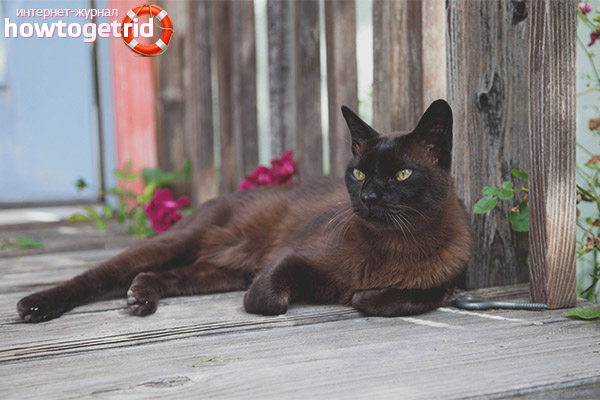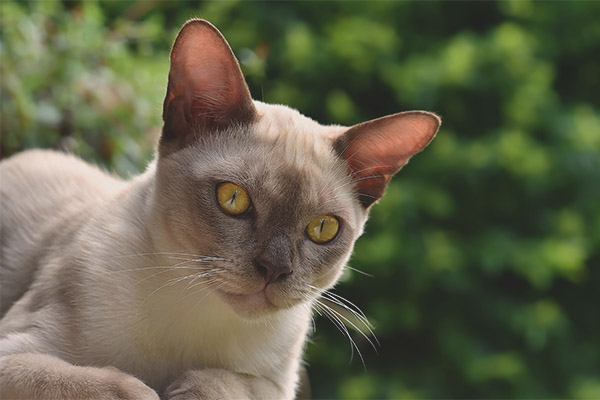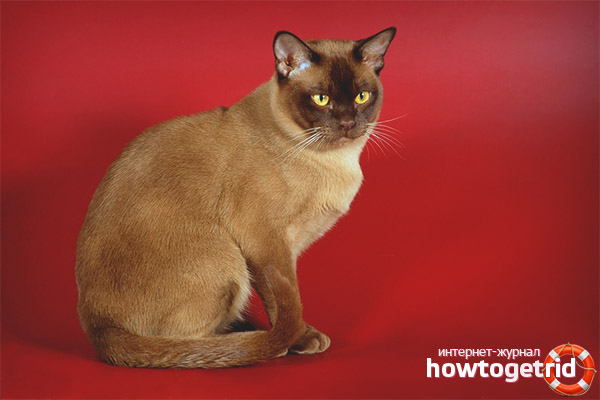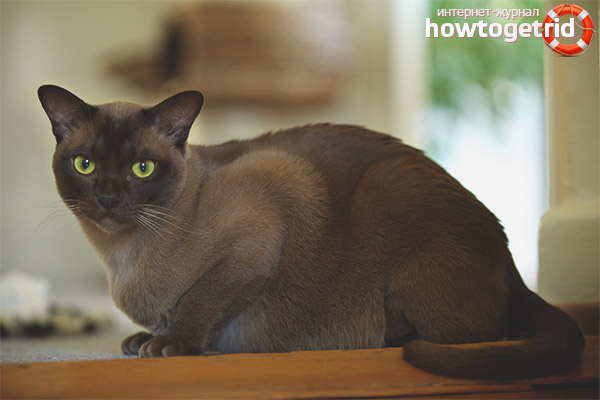The content of the article
- 1 From the history of the breed
- 2 Description
- 3 Colors
- 4 Character traits
- 5 Health
- 6 Features care and maintenance
- 7 Nutrition
- 8 Restroom
- 9 Hygiene procedures
- 10 De-worming
- 11 Mating
- 12 The walks
- 13 Burmese cat and allergies
- 14 How much does a burmese cat cost?
- 15 Where can I buy a Burmese cat?
- 16 Video: Burmese cats
Burmese cats have an extraordinary and unforgettable appearance. They are not only beautiful and aesthetic, seeing once - they are simply impossible to forget. Burmese cats have wool similar to silk magically shimmering in the sun.
From the history of the breed
Homeland Burmese cats - Southeast Asia. On the territory of Europe and America, they appeared fairly recently, namely in the nineteenth century, but they were still considered representatives of Siamese cats for a long time. There they were brought by the efforts of Dr. J. Thompson, who liked atypical Siamese cats of brown colors and amber eyes.
In the 30s of the twentieth century, he brought from Burma an animal named Wong Mau to Los Angeles. It was she who became the first Burmese cat.Armed with the support of breeders Virginia Cobb and B. Jerts, as well as geneticist Clyde Killer, J. Thompson proved that Siamese cats and Burmese are two separate breeds. Subsequently, in the 36th year, the CFA adopted official standards for the breed of Burmese cats. After which they became extremely popular, but this did not benefit them.
Because the Burmese became very popular, and the breeders knew little about it, they began to cross them with the Siamese. This led to the fact that in the 47th year of these cats have ceased to allocate a separate breed and considered Siamese.
10 years later, the American community was brought under the responsibility of breeding a Burmese cat.
Description
Their appearance combines classic elegance and unobtrusive severity. All external characteristics of the Burmese are surprisingly in tune with each other. Honey amber eyes - the highlight of the animals of this breed. They reflect the intellect, curiosity and confidence that touch the human soul. Without a doubt, they become the main conductor in relations between people and Burmese cats.
In addition to the magical eyes, Burmese are distinguished by the tenderness and silkiness of a fur coat that plays in the sun, with a special radiance. This spectacular zest of small length and allows you to see the harmonious physique of the animal, as well as its extraordinary grace.
Regarding the Burmese, one more interesting feature is worth noting - this cat has a rather large weight, despite its external shape and body size. For her, and they were called "silk bricks."
According to generally accepted standards, a Burmese cat should have the following characteristics:
- Body. Medium size. Build strong. Thorax well developed, rounded.
- Head. Wedge shaped. With soft rounded contours. With wide and expressive cheekbones. The chin is well pronounced.
- Limbs. Long and thin, proportional to the body of the cat.
- Eyes. Big size. Set wide. The lower eyelid is more rounded, and the upper one looks relatively more straight. Honey, yellow, amber shades.
- Ears. Large size relative to the head. Widely set. With a wide base and little rounding at the tips.
- Tail. It has an average length relative to the body of the animal. The base is not wide enough, but wider than the tip.
- Wool. Silky and soft. Short length with pronounced shine. Tight fit to the body. Without undercoat.
Colors
Burmese cat has a lot of options for the original colors.
- Brown (brown). Wool has a warm brown shade. The color of the ears and muzzle is somewhat darker than the body. Pillows on paws and nose are dark brown. Drawbacks are considered drawings. Eyes warm brown and gold shades.
- Auburn (red). Ginger shade of wool. The nose and paw pads are pink. Eyes of warm brown and gold shades. The disadvantages are the presence of bands along the body, which are typical for tabby colors.
- Blue (blue). Cold gray shades of wool. Muzzle, tail and paws are darker. Nose and pillows paws gray. Eyes of any brown and golden shades. The disadvantage is any pattern.
- Chocolate. The coat color is cold brown. The muzzle, tail, and paws are several tones darker than the body. Nose and pillow paws chocolate color. Eyes of brown and golden shades. Drawings on the cat's body are not allowed.
- Tortibraun (tortoise brown). Characteristic turtle color all over the cat's body, with spots of red and light color on a brown background, evenly distributed over the cat's body. The nose and paw pads can be of any color to match the base coat or stains. Eyes of any brown and gold shades. Invalid pattern on specks.
- Lilac (lilac). Light - gray shade of wool with pink. Tail, muzzle and paws more saturated color. The paw pads and the tip of the nose match the color of the coat. Eyes of brown and golden shades. The disadvantage is any pattern on the body of the cat.
- Blue tortie (blue turtle). The combination of cream and blue spots in coat color. The paw pads and the tip of the nose are light pink, gray in color. Eyes of any brown and gold shades.
- Lilac torti (lilac turtle). Lilac and cream spots, combined in coat color. Pillows paws and the tip of the nose of purple tones. Eyes of any brown and gold shades. The presence of any pattern is considered a disadvantage.
- Cream. The color of wool has a delicate shade of ivory of varying intensity. The paw pads and the tip of the nose are pink.Eyes can be any brown and golden shades.
- Chocolate turtle. Chocolate and cream spots on the cat's body. Muzzle, paws, tail of a darker tone. The tip of the nose and pillow paws pink or chocolate shades. Eyes of brown or golden colors.
Character traits
The Burmese cat, due to the nature of its character, does not always suit people with a calm and phlegmatic disposition, since it is an animal extrovert. This animal is very sociable and often refers to it as well.
Cats of this breed love to play and have fun in all possible ways. She can show performances, demonstrating her physical abilities, sometimes making sure that she has a public. She can leave a marvelous jump without realization, without having a spectator, for which she comes up with various tricks. Burmese have a stubborn temper and the ability to bring the job started to the end.
They do not have a loud voice, unlike the Siamese. However, they can conduct “purring” dialogues with the host.
Contrary to their external independence and inherent playfulness, the Burmese are very affectionate and loving. They need to receive attention and universal acceptance.Their masters point out extraordinary devotion and affection towards a person.
Burmese cats do not like loneliness. At the same time they get along well with other pets in the house. To the Burmese was not boring in the absence of the owner - they can be charged under someone's temporary custody.
Health
The Burmese cat has relatively good health and a good life expectancy - about 16 years. Of the possible diseases characteristic of this breed, problems with the upper respiratory tract, as well as dental diseases can be attributed. To prevent the possibility of such problems, it requires good nutrition and careful care of the oral cavity. Vitamin complexes for cats should be introduced into the diet.
Possible characteristic diseases for the Burmese also include: tearing and labored breathing due to the specific structure of the olfactory organs, the possible deformation of the skull in kittens at birth.
Features care and maintenance
This short-haired cat breed does not cause major problems during periods of molting. To protect your home from the abundance of wool in it, you need to carry out a wet hand on a pet's fur coat once a day or use a special glove.
Bathing cats is also not necessary often.This can be done only in cases of special need. Before exhibitions, the cat should be washed no later than 5 days in order for the wool to take on its natural styling.
Nutrition
Nutrition Burmese, like any other cat, should be of high quality and integrated. Often cats of any breed are fed based on their taste preferences. This should not be neglected, but it is imperative to include other important products besides delicacies.
The best option is to combine homemade food with high-quality dry food. Good quality food often contains essential vitamins and trace elements. In addition, the use of dry feed is simply necessary in case of a long absence of the owner. An adult cat in rare cases will give preference to feed over quality meat or fish. Therefore, to teach your pet to the peculiarities of nutrition is necessary from an early age. Also, the kitten should be taught to a balanced diet, namely, cereals and vegetables, in addition to meat and fish.
For a cat you need to have at least two special bowls, one for food, the second for water.It is very good when it is exactly specialized dishes that are fixed on the floor surface. Then the pet will not rumble during the night meal, and disturb the sleeping hosts.
Restroom
Without it, can not do. The hygienic culture of cats is an important condition for its good relationship with the owner. As a rule, the responsibility for observing the standards of cleanliness in the house on the owner and go to bed. Burmese cat - the animal is quite intelligent and intelligent, it can be accustomed to the toilet. If there is no such desire and need, then you should get a special tray.
It is necessary to teach a cat to the toilet from the first day of its appearance in the house.
Hygiene procedures
Diseases of the teeth are characteristic of Burmese cats. To keep the oral cavity safe and sound - the cat just needs to brush its teeth and include solid food in the diet. Dry food, chicken and beef cartilage, etc.
You need to brush your teeth regularly, once or twice a week to prevent the appearance of plaque and stone. For this purpose, special toothpastes intended for cats are used.Cleaning can be done with a special brush, baby toothbrush or cotton pad. To clean the cat's teeth, it is necessary with one hand, gently squeeze and fingers gently press between the jaws. The second hand to make the procedure. To accustom an animal to this process is necessary from an early age from the moment the pet appears in the house. Adult cat adapt to the hygienic procedure is almost impossible. This can be done only once, but then the animal simply will not allow any hint of such “bullying”.
Cleaning the ears and eyes is also an important procedure. You need to produce them every 7-10 days. To do this, you need to wipe the cat's ears and eyes with a cotton swab or disc barely soaked in warm water.
De-worming
Any, even the most homely and sleek kitty is not immune from parasites. There are many factors and ways of infection of the animal with round and tapeworm worms. This is dangerous in that it can cause intestinal obstruction in an animal and can be fatal. In addition, a cat with helminthic invasion can feel discomfort, a fall in immunity and get a state of general intoxication.To avoid such problems, prophylactic deworming should be carried out once a quarter or six months.
For these purposes, special preparations are used, necessarily complex actions (on round and ribbon parasites) in the appropriate dosage and in full compliance with the instructions and safety measures.
This procedure can be carried out kittens, preferably from one month of age. Cats and cats need to be given anthelmintic drugs before vaccinations and without fail before planned viscous.
Mating

Before you take a cat for breeding, you must determine the floor. He plays an important role not only because of the personal preferences of the future owner - the floor is selected taking into account the subsequent conditions favorable for breeding. Before you take a cat that will become a mother of purebred kittens, you need to think about whether the hostess or the owner is ready for the risks and possible consequences, as well as responsibility. Many believe that the problems and fuss with a purebred cat involved in breeding are much less. But this opinion is wrong. Since it is the owner of the cat is usually faced with the constant nasty screams and spoiled sofas and sneakers.
Both the cat and the cat must have enough space in the house, the cat for cattle, the cat for raising kittens.
The walks
Any living creature, including cats, requires that it be released to take a walk in the fresh air. It is natural that a purebred cat, especially valuable for breeding, is taken for a walk on a leash. In the case when the owner has a private house with a separate courtyard, the animal can be released for walking into the yard on their own without additional security measures. But, this can be done only if the yard is well cared for and other animals (dogs) do not pose a danger to the pet.
Burmese cat and allergies
How much does a burmese cat cost?
Those who wish to buy a pet of this breed, you can say, lucky, because they are relatively inexpensive. The price depends on the gender, class (pet, breed, show), as well as the place of purchase (exhibitions, nurseries, private person). A cat breed of Burmese will cost from $ 200 - pet class, and above. The price of a cat for breeding with good pedigree characteristics can be about $ 1,000.
Where can I buy a Burmese cat?
This cat breed is not rare. It is quite common in the world and the countries of Russia and Ukraine. Practically in all large cities there are several nurseries and many private breeders.
Video: Burmese cats














To send